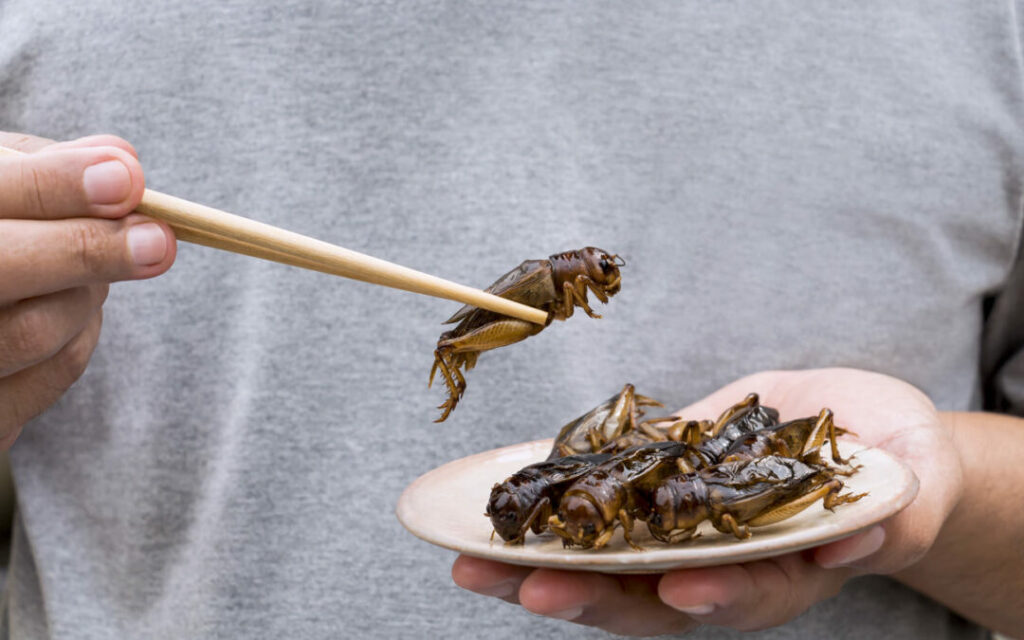Over two billion people worldwide include insects in their diets. The historical reasons why insects were chosen as food in many parts of the world are multiple and, whereas today there can be a cultural or traditional aspect, the choice was often made out of necessity. Nevertheless, many insect species are digestible and are efficient in converting what they eat into proteins and fat.
It can be surprising, therefore, that on the three continents, Africa, Asia and Latin America, where insects feature in peoples’ diets, there is no insect livestock industry to speak of. Insects are mostly picked - or hunted - wild or reared in small, family size facilities. On the continents where there is neither an insect eating tradition nor necessity, Europe and North America, an intensive insect production industry is burgeoning.
This industrial activity, over recent years, is visible through startups that have begun selling whole insects and insect enriched food products, firstly online and in specialised shops and, more recently, through deals with continent-wide supermarket chains.
Touting environmental qualities compared to meat consumption, quirky packaging and irreverent marketing, insect-based food products have made the headlines. However, industry activity around insect production goes well beyond the niche, novel food sector.
Ticking all the sustainability boxes?
Conscious of animal farming’s heavy environmental and health impacts, the EU has come forward with a Farm to Fork strategy, as part of its Green Deal. Its goal is to promote healthier plant-based diets. It foresees reducing meat and fish consumption and, therefore, be able to move towards less intensive animal farming systems with higher welfare standards.
To roll out its ambitions, the European Commission is working on a Sustainable Food System framework, highlighting how meeting the EU’s objectives requires looking at and reforming the food system as a whole. Therefore, a successful sustainable food system framework will enshrine the foundational principles of the Farm to Fork strategy in all food and agriculture legislation.
In this context, the Commission is actively promoting insects as their production seems to tick all the policy boxes: less climate change emissions, less water use, less land-use and a solution to the EU’s protein deficit that requires imports of protein-crop from other regions of the world.
Yet insects as food are a small fig leaf covering a larger industry who’s ultimate environmental credentials still need to be demonstrated. In fact, promoting insect farming may well be a good way of propping up intensive animal farming and maintaining excessive amounts of meat and fish on Europeans’ plates.
The fig leaf and the mealworm
Industry analyst and investor, Rabobank, calculated that of the money raised by the insect industry in 2020, only 37% was for the development of food products. Industrialisation of the insect producing sector lies in feed for animals, not food for humans. In fact, it is expected that insects as food will remain a niche market in Europe and the US, at least for the foreseeable future.
Up until a few years ago, volumes in insect production have mainly been sustained by the pet food industry that can use insects as protein supplements. However, the European Union gave a boost to industrial insect production first in 2017 by authorising insect feed in aquaculture and, recently, in 2021 authorising insects in poultry and pig feed.
These policy changes are the root of the insect production industry’s take off in Europe. Rabobank notes that in 2018 investments in the insect production industry tripled compared to the previous year on the back of the 2017 aquafeed authorisation. In 2020, with the prospect of authorising insects in poultry and pig feed, investments in the industry shot up fourfold compared to 2018.
Antoine Hubert, CEO of French insect producing giant Ÿnsect, confirmed in a February 2022 interview with Wired that half of his company’s revenue is in pet food and that the decision to build what will be the largest european insect producing facility in Amiens, France, was taken on the back of the EU authorisation of insects in animal feed. In fact, food products represent only 5% of Ÿnsect’s turnover.
According to industry analysts, many insect producers focus on products to replace fishmeal in aquaculture. The Dutch insect producer Protix currently runs the biggest insect producing facility in Europe and made the investment to produce fishmeal.
Insects don’t quite have the right genes
Of the seven insect species authorised in feed in the EU, none truly offer the possibility to scale production to the point it becomes competitive in the feed market compared to the cheaper alternatives, such as soy, according to Hubert. Despite their high protein conversion rates and very short life cycles, the industry’s insects of choice are still too small and grow too slowly.
In 2021, insect meal was up to 12 times as expensive as soy meal and four times as expensive as fishmeal per tonne. According to Rabobank, insect meal costs between €3,500 and €5,500 per tonne. In October 2021, fishmeal was trading in international markets at just under €1,300/t and soybean meal at under €400/t.
Cost of insect, fish and soy meal per tonne, October 2021:
[caption id="" align="alignnone" width="842"] Sources: Rabobank 2020 and Indexmundi 2021[/caption]
With the appropriate production upscaling and further removal of regulatory barriers, insect meal could become competitive with fishmeal by the early 2030s, but still be way off soy, precluding the insect production industry from a large chunk of its potentially biggest market.
Consequently, the insect production industry is turning to genetic breeding and genetic selection: Ÿnsect, Protix, Beta Bugs and others are all investing in insect genetics. The aim is to produce bugs that grow faster and bigger, because insects’ existing genes are, at the end of the day, a problem.
More meat on the menu in the EU?
Yet the flaw in the insect production reasoning is more fundamental. A dramatic reduction in meat and fish consumption and the consequent move away from industrial farming practices, will also reduce the quantities of animal feed required.
As the insect production industry is, essentially, a feed industry, it is unclear why it would require such significant upscaling, including through manipulation of the actual insects. The insect industry, therefore, is gearing up to supply a sustained intensive animal farming system, in stark contradiction to where the EU says it wants to be.
Industrial insect production should, therefore, not fit into tomorrow’s sustainable food system. In a system where livestock industries should, according to the EU’s policy choices, diminish and move away from intensive and industrial processes, we are witnessing the creation of a new intensive livestock industry whose main customers are the other intensive livestock industries.
Although there is a lot of buzz around this exciting new European industry, it seems, nevertheless, necessary to proceed with a little caution. Lest the insects fly in the face of the EU’s objectives.


